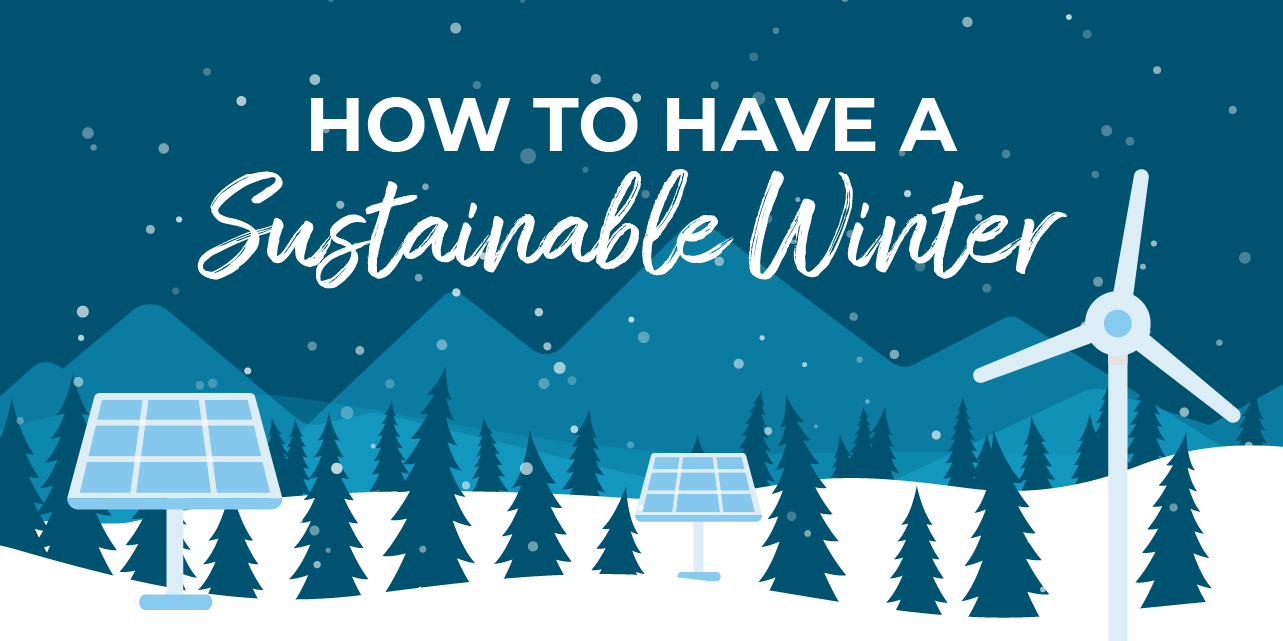As winter’s shorter days, less sunlight and seasonal fatigue set in, we can lose focus on the role we play in protecting nature. Welcome the season’s cozy embrace — and the extra time spent indoors — with a sustainable winter revamp. From eco-friendly travel choices to mindful kitchen habits, cleaner personal care practices and more, you can make powerful changes that really add up. Explore our sustainable winter tips for a greener home and planet.

Traveling — whether by plane, train or automobile — impacts the planet. That fact is becoming harder to ignore, with 57% of holiday travelers saying that sustainable travel is important to them. To shrink your carbon footprint and still enjoy a winter getaway, you can:
- Choose a cleaner transport option. If you’re heading a few hours away, consider a train instead of a flight. If you’re renting a car at your destination, opt for an electric vehicle. And if you can get around just fine on public transportation, ditch the rental car all together.
- Act like a local. Instead of hopping from one city, state or country to another, try slowing down and enjoying a longer stay in one location. In addition to using less fuel, you’ll get to immerse yourself in the food, culture and history of your chosen locale.
- vOffset your travel. Make your journey more planet-friendly by purchasing carbon offsets. It takes only $10 to offset a round-trip flight or cross-country flight from New York City to Los Angeles.

Adults in the U.S. spend an average of 67 minutes in the kitchen each day. This high-usage area is a great candidate for a sustainable makeover. Discover the joy of eco-friendly cooking (and eating!) with these tips:
- Consider your cookware. Eat sustainably with options like ceramic-coated cookware and coated stainless steel. These are healthier, longer-lasting alternatives to chemical-laden (looking at you, non-stick Teflon) and lead-leaching (hi, uncoated aluminum) pans.
- Minimize food waste. The USDA estimates that between 30% and 40% of the food supply in America is wasted each year. Stop food waste in your home by shopping with a list, eating food before it spoils and getting creative with leftovers.
- Compost food scraps. Another way to avoid food waste is to compost fruit and veggie peels, coffee grounds, eggshells, tea bags and more. You can even do it indoors!

It’s easy to forget about the environmental impact of clothing — which is all the more reason to take a closer look in the closet this winter. Globally, the fashion industry contributes about 40 million tons of textile waste a year. You can help reduce that waste by adopting more sustainable clothing habits. Try to:
- Shop secondhand stores. More than 25,000 resale, consignment and not-for-profit resale shops exist in the U.S., plus countless online options such as ThredUp and Poshmark. With all this excess merchandise so readily available, there’s no need to add more pollution to the planet by purchasing new clothes.
- Choose sustainable materials. Check labels for organic cotton, hemp, organic linen, organic bamboo and lyocell. They have less of an environmental impact than polyester (made from fossil fuels), rayon (made from wood pulp that can contribute to deforestation) and regular cotton (which requires a significant amount of water to grow and process).
- Ditch fast fashion. Just say NO to cheap, trendy clothing produced from low-quality materials. Take the road less traveled by building a sustainable winter wardrobe with fewer but well-made, long-lasting and timeless garments.
- Maintain your clothing. Laundry uses electricity and water, causes extra wear on your clothing and can release harmful microplastics into waterways. For a more eco-friendly way to do laundry, try some or all of the following: wear clothes a few times before laundering (unless they really need a wash), use the cold-water option, run only full loads and hang your laundry to dry.

The winter months can bring dry skin, chapped lips and the overwhelming urge to stay under a warm blanket every waking minute. To keep things sustainable and hygienic this season, try to:
- Choose products carefully. From soaps and shampoos to skincare, perfume and makeup, opt for eco-friendly products. That may mean looking for the U.S. Department of Agriculture organic seal or the Fair Trade Certified™ symbol, checking product ingredients on the Environmental Working Group (EWG) Skin Deep® database or simply choosing items with natural ingredients and less packaging.
- Shower smarter. Hot water not only takes energy to heat, but it can also strip your skin of essential oils. Keep your skin clean and healthy by taking a shorter shower that’s not quite so hot. Round out your sustainable shower with a natural loofah, a stainless steel razor and a cloth shower curtain liner.

We’d be remiss if we didn’t mention energy efficiency as part of a greener winter. Every kilowatt-hour saved is a win-win for your electricity bill and the planet. It’s easier than you think to lower your energy usage without sacrificing your comfort zone:
- Tame your thermostat. For every degree below 68°F, you can save around 3% on your heating costs. So set the temperature 4° lower if you’ll be away for more than four hours.
- Utilize fans. Setting your ceiling fans to rotate clockwise so they can recirculate warm air allows you to turn down the temperature a bit.
- Explore your options. If you have a smart thermostat, you may be able to sign up for a demand-response program like Ready, Set, Relax. You’ll help conserve energy during periods of high electricity usage by allowing your thermostat to be automatically adjusted. Plus, you could also earn a bill credit just for participating.
- Make solar your backup. Stay powered up during weather-related events or power outages with Goal Zero backup solar-powered products. Nothing beats clean energy!
- Embrace renewables. Speaking of clean energy, powering your home with 100% renewable energy is one of the easiest way to reduce your carbon footprint — not just in winter but all year long.

Looking for even more ways to make this winter more sustainable? Check out these bonus green-living tips for other areas of your home:
- Recycle mail packaging. You’ve probably had to deal with post-holiday paper waste, or the cardboard evidence of an online shopping splurge. The responsible and sustainable solution is to properly recycle any mail, cardboard and gift wrap that enters your home.
- Go green — literally. Start an indoor garden to improve the air quality in your home — as well as stay connected to nature and even harvest some of your own herbs to use in your kitchen.
- Repair before you replace. When something breaks, instead of immediately tapping Buy Now from your cozy spot by the fireplace, consider a more planet-friendly approach: try repairing it first. A how-to video on YouTube could be all you need to restore your item to its former glory.
We hope these tips help you refocus on the power of your personal impact this season. Every positive change adds up to a cleaner, greener home — and planet! So embrace the chance to make your life a sustainable winter wonderland.
Make every season more sustainable with clean energy.
Choose 100% renewable electricity today.







